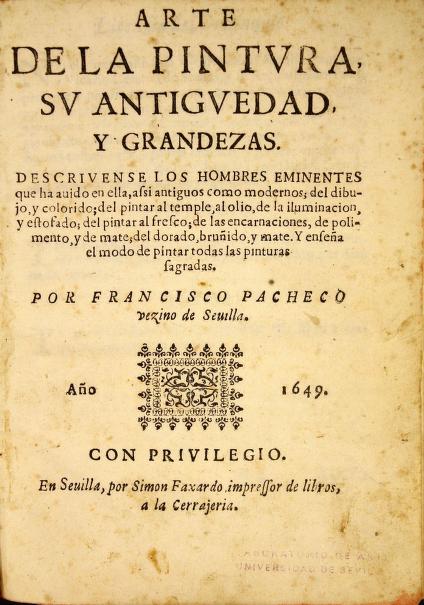
Frostispiece of Pacheco, El Arte de la pintura (1649), Seville, Simon Faxardo, impressor de libros, a la Cerrajeria
Dealing with the story of St. Christopher, Pacheco analysed how the saint should be depicted. He doubts, according to Molanus studies, about depicting the St. Christopher giant. Pacheco states, following his literature sources, that the saint was tall and with great stature, although not as tall as he is often depicted.
“After the Apostles, it is only fair to mention some saints who have something to note, keeping in order their antiquity, and the one who is offered to us first is the glorious martyr St. Christopher […]. Father Rivadeneira says that it is commonly painted with the Child Jesus on his shoulder as if he were passing through a river, and I do not see what basis there is for painting him in this way. And, before this, he does not say that he was a giant, but rather that he was of gentle disposition and tall and great stature, although not as tall as he is depicted; and that he carried a stick in his hand and, having thrust it into the earth, it suddenly became green and flourished; and, having seen this miracle, many were converted to the faith of Christ our Lord. This painting of him with the Child on his shoulders, which is his ordinary painting, as far as it is known, cannot be avoided, but Molano also doubts it […]. And because the intent of this mysterious painting is supported by the elegant Latin verses that the Licentiate Francisco Pacheco, my uncle, canon of the Holy Church, celebrated for his good wit, painted on the St. Christopher of the main Church of this City, which we spoke of once before, painted by Mateo Pérez de Alecio, the Licentiate Francisco Pacheco, my uncle, canon of the Holy Church, will give the reader a glimpse of them […]”.
“Justo será reparar después de los Apóstoles, en algunos santos que tienen algo que advertir, guardando en el orden su antigüedad y el que se nos ofrece primero es el glorioso mártir San Cristóbal, […]. Comúnmente, se pinta con el Niño Jesús en el hombro, como que le pasa por un río, dice el P. Rivadeneira, y no hallo qué fundamento tenga el pintarlo asi. Y, antes desto, no dice que era gigante, si bien que era de gentil disposición y alta y grande estatura, aunque no tanto como se pinta; y que traía una vara en la mano y, habiéndola hincado en la tierra, súbitamente reverdeció y floreció; y, visto este milagro, munchos se convirtieron a la fe de Cristo nuestro Señor. Esto de pintarle con el Niño en los hombros, que es su ordinaria pintura, por donde es conocido, no se puede huir, pero también lo pone en duda Molano […]. Y porque abrazan el intento desta misteriosa pintura los elegantes versos latinos que puso en el San Cristóbal de la Iglesia mayor desta Ciudad de que hablamos tra vez, que pintó Mateo Pérez de Alecio, el Licenciado Francisco Pacheco, mi tío, canónigo de la Santa Iglesia, celebrados de los buenos ingenios, haré gracia delos al lector […]”.
Pacheco (1990), 674, n. 55; Pacheco (1990), 678-680, n. 67-70;



